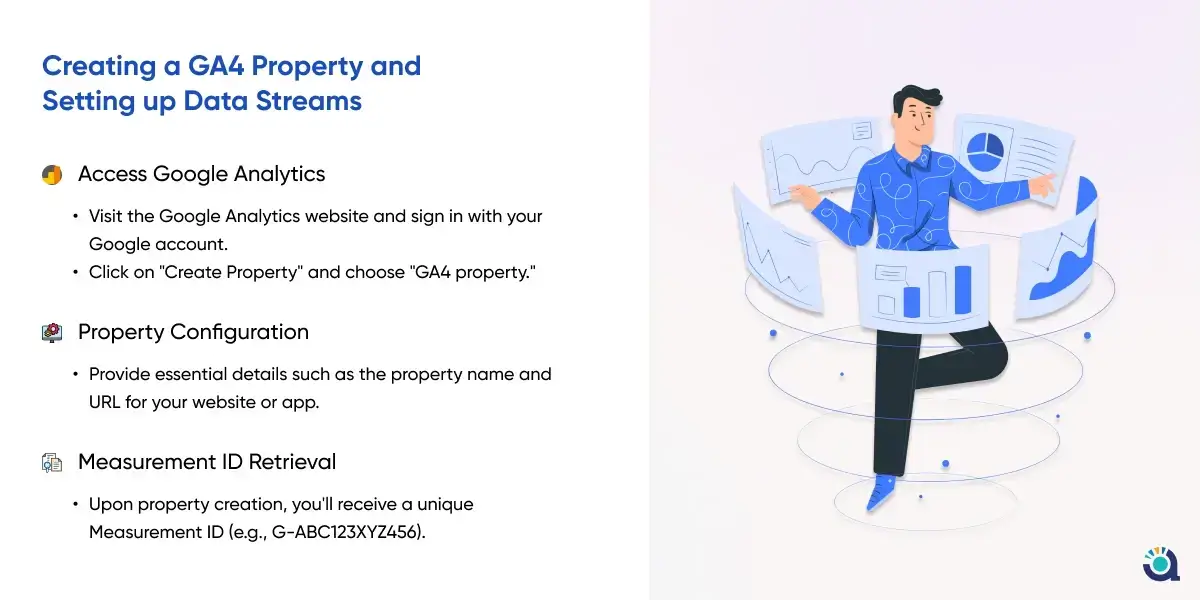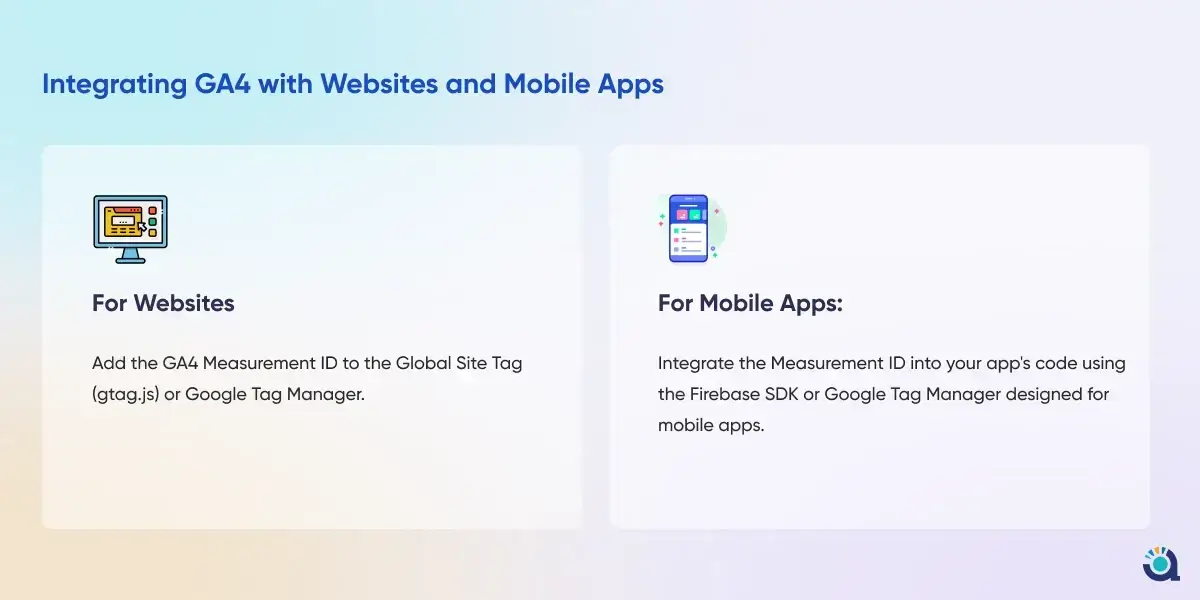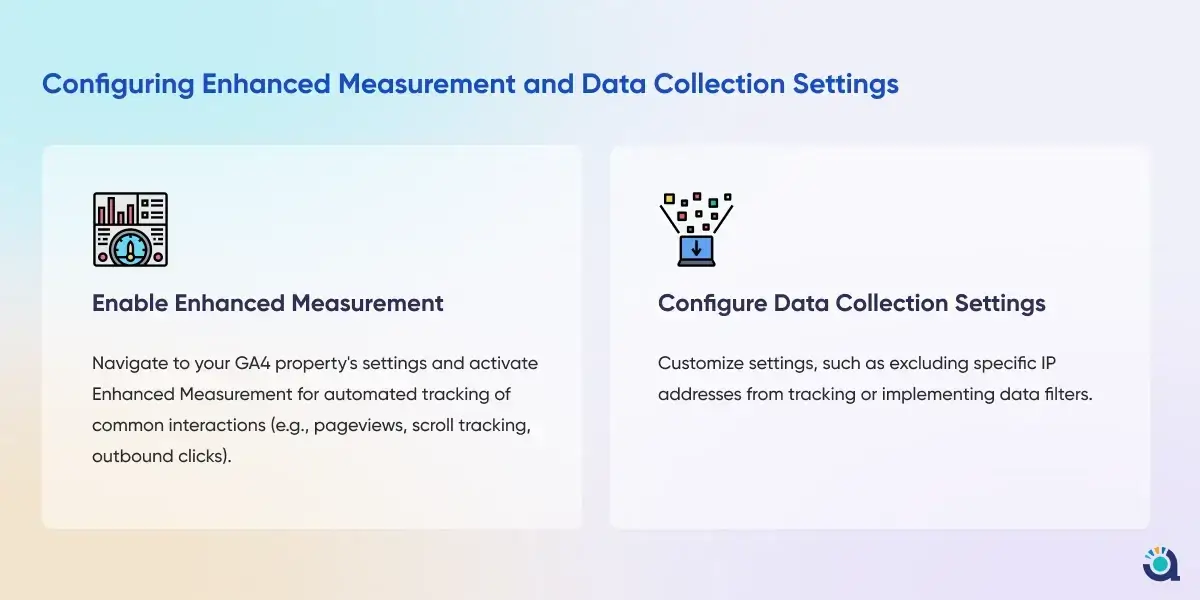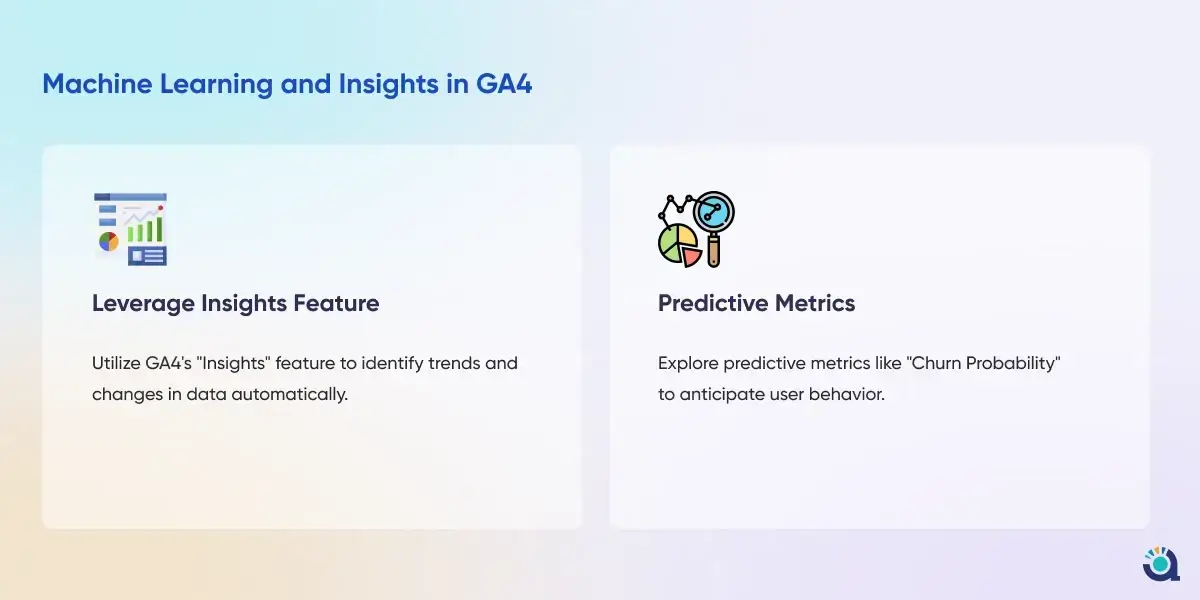As we step into 2024, the digital landscape continues to evolve, and so does the world of analytics. Google Analytics 4 (GA4) emerges not just as an update but as a complete reimagining of how we measure and analyze data. As a GA4 expert, let’s delve into the depths of this transformative tool and explore how it can pave the way for marketing excellence in the coming year.
Understanding the GA4 Landscape

Overview and Key Features
GA4 transcends its beta version, “App + Web,” to offer a more insightful, cross-device, and privacy-driven approach to analytics. To fully harness its power, understanding its key features is crucial.
a) Enhanced cross-platform tracking
GA4 goes beyond traditional analytics by seamlessly tracking user interactions across various devices and platforms. Whether users navigate from your website to your mobile app, GA4 captures the entire journey.
Google Analytics 4 (GA4) now combines data from both the web and apps in one place, making it better at understanding how people use them. It uses different methods (like looking at user IDs, Google info, device IDs, and behaviour modelling) to keep track of users across devices.
Understanding how users interact with your website or app is crucial for success. Google Analytics 4 (GA4) takes user tracking to a new level with a robust approach that utilizes three key tools:
- User ID: The gold standard. This method recognizes users who log in, providing a crystal-clear view of their entire journey across different devices. Imagine a user seamlessly moving between their phone and laptop – GA4 with User ID tracks them as a single entity, not separate interactions.
- Device ID: Ever logged into a website on your phone and then found yourself unrecognized on your laptop? That’s Device ID at play. While it effectively tracks individual devices, it assigns a new ID for each one. This can lead to missed insights if users switch devices frequently.
- Modeling: Not everyone wants their data tracked, and that’s okay. GA4 bridges this gap with modeling. This statistical approach analyzes existing data to estimate user behavior for those who opt out. Think of it as filling in the missing pieces of the puzzle to provide a more comprehensive picture.
GA4 prioritizes these methods in a specific order to create the most complete picture possible. User ID takes center stage when available, followed by Device ID, and finally, modeling helps fill in the gaps. This ensures you gain valuable insights regardless of user preferences.
The benefits of GA4’s comprehensive approach extend far beyond basic website analytics. Whether you’re a publisher, marketer, web analyst, or conversion rate specialist, GA4 empowers you to make data-driven decisions that drive real results.
b) Event-Driven Data Collection
With an emphasis on events, GA4 provides a more nuanced understanding of user engagement. This is an important metric as it reflects on how your users are engaging with your pages as it registers all the user interactions as events, rather than simply emphasizing what events or actions a user has taken on your website.
In GA4, you have the power to create custom events for your e-commerce website effortlessly. For instance, you can track actions like adding a product to the wishlist or applying a coupon code, all without needing to write extra code. Moreover, GA4 lets you gather a wealth of information about these events, such as product details (name, category, price, quantity), providing a comprehensive view.
GA4 is well-equipped with in-built features for e-commerce, including specific events like add_to_cart, begin_checkout, and purchase. This built-in support simplifies the tracking of crucial e-commerce actions, eliminating the need for manual event creation.
c) AI-Driven Insights
Embracing machine learning and AI, GA4 ventures into predictive analytics. This becomes particularly significant in the era of cookie-less privacy, where machine learning maps old user data to guide data-driven decisions for upcoming campaigns.
The machine learning feature of GA4 enables you to capture important data about the users who have opted out of “Cookies”. In the cookie-less privacy driven era, the machine learning feature GA4 maps all the old data about the user, allowing you to make data-driven decisions about upcoming campaigns.
By analyzing how users have interacted with your website or app in the past, GA4 provides insights into potential future actions. According to Backlinko
GA4 showcases these predictions through its AI metrics, including:
Churn probability: This predicts the likelihood of a user, active in the last 7 days, not being active again in the next 7 days.
Purchase probability: It estimates the chances of a user, active in the last 28 days, making a conversion in the next 7 days.
Revenue prediction: GA4 forecasts the expected revenue over the next 28 days from a user who was active in the last 28 days.
These AI-driven metrics empower you to anticipate user behaviour and make informed decisions for your website or app.
d) Enhanced Integration with Google Ads
GA4’s integration with Google Ads has evolved to a new level. Advertisers can now gain a more comprehensive understanding of how their ads perform across different channels, considering the entire user journey on the website.
Google Ads has made an important update to improve how it uses data from your website. Now, it can understand and use more detailed information about user actions on your site, not just those coming from Google ads. This means advertisers can get a more accurate picture of how their ads are performing across different channels.
Previously, Google Ads only paid attention to the last action a user took before making a purchase or completing a goal on your site. Now, it looks at the entire journey a user takes on your site, even if the last thing they did wasn’t from a Google ad. This helps advertisers see the value of different marketing channels in a more complete way.
To use this feature, advertisers need to connect their Google Analytics and Google Ads accounts. By doing this, they can access more information about how users interact with their ads and use that data to make better decisions about their advertising strategy.
If you’re an advertiser, it’s also important to make sure your website’s data is set up correctly to take advantage of these improvements. This update is part of a larger shift in how Google tracks and uses data, so it’s a good idea to stay informed about these changes to get the best results from your advertising efforts.
- e) Funnel Exploration Feature
The shift from a single-screen to multi-screen and the absence of third-party cookies present new challenges. The digital ecosystem is evolving, demanding changes in data collection and transformation strategies. Privacy has become a top priority, requiring explicit consent from users. Marketers need to adapt to users not being tracked, impacting remarketing efforts.
1. Creating a GA4 Property and Setting up Data Streams
Initial Steps:
To initiate the GA4 setup, follow these steps:
- Access Google Analytics:
- Visit the Google Analytics website and sign in with your Google account.
- Create a New Property:
- Click on “Create Property” and choose “GA4 property.”
- Property Configuration:
- Provide essential details such as the property name and URL for your website or app.
- Measurement ID Retrieval:
- Upon property creation, you’ll receive a unique Measurement ID (e.g., G-ABC123XYZ456).
Example Scenario: “AwesomeShop”
Imagine you own an e-commerce website named “AzwesomeShop.” After creating a new GA4 property named “AwesomeShop Website,” you’ll be assigned a Measurement ID like “G-ABC123XYZ456.”
2. Integrating GA4 with Websites and Mobile Apps
Implementation Process:
- For Websites:
- Add the GA4 Measurement ID to the Global Site Tag (gtag.js) or Google Tag Manager.
- For Mobile Apps:
- Integrate the Measurement ID into your app’s code using the Firebase SDK or Google Tag Manager designed for mobile apps.
Continuing with “AwesomeShop”:
In the case of “AwesomeShop,” you’ll add the Measurement ID “G-ABC123XYZ456” to the global site tag on your website’s pages. This step ensures that GA4 begins tracking user interactions on your site effectively.
3. Configuring Enhanced Measurement and Data Collection Settings
Optimization Techniques:
- Enable Enhanced Measurement:
- Navigate to your GA4 property’s settings and activate Enhanced Measurement for automated tracking of common interactions (e.g., pageviews, scroll tracking, outbound clicks).
- Configure Data Collection Settings:
- Customize settings, such as excluding specific IP addresses from tracking or implementing data filters.
Application to “AwesomeShop”:
For “AwesomeShop Website,” activating Enhanced Measurement ensures automatic tracking of relevant events, enhancing the depth of insights.
4. Machine Learning and Insights in GA4
Unleashing Predictive Analytics:
- Leverage Insights Feature:
- Utilize GA4’s “Insights” feature to identify trends and changes in data automatically.
- Predictive Metrics:
- Explore predictive metrics like “Churn Probability” to anticipate user behavior.
Real-World Application:
Imagine discovering through GA4 insights that users from a specific region exhibit increased engagement on weekends. Armed with this knowledge, you can implement targeted weekend promotions, resulting in elevated sales.
Understanding Events and Conversions in GA4
Event-Driven Data Model:
Google Analytics 4 (GA4) employs an event-driven data model to track and measure user interactions on digital properties. Events serve as the fundamental building blocks for data collection, representing actions users take, including clicks, pageviews, video plays, form submissions, and more. Each event consists of parameters providing additional details about the action.
Custom Events and Conversions:
GA4 offers the flexibility to create custom events tailored to specific tracking needs. These events go beyond predefined actions, allowing businesses to track actions critical to their objectives. Conversions in GA4 signify the successful completion of actions considered valuable, such as making a purchase or signing up for a newsletter.
Analyzing Event Data for Insights and Optimization:
Analyzing event data in GA4 is crucial for gaining insights into user behavior and optimizing digital properties. Key analysis methods include leveraging event reports, conducting funnel analysis, evaluating user engagement metrics, and utilizing segmentation for a more granular understanding.
Example Scenario: For an online bookstore using GA4, tracking the “AddToWishlist” custom event reveals user engagement. Analyzing data might show that although users frequently add books to wishlists, only a small percentage convert to purchases. This insight prompts strategic marketing adjustments.
GA4 Reporting: Exploring the New Interface
Reporting Dashboard Overview:
The GA4 reporting dashboard provides a holistic view of the website or app performance and user behavior. Key features include the home overview, real-time data, acquisition reports, engagement reports, monetization reports, retention reports, funnel analysis, explore reports, custom reporting, data analysis hub, and automated insights.
Tip: Regularly explore and familiarize yourself with the reporting dashboard to stay informed about your digital property’s performance.
GA4 and Enhanced Data Privacy: Complying with CCPA and GDPR
Data Privacy Features:
GA4 incorporates enhanced data privacy features to facilitate compliance with regulations like CCPA and GDPR. Features include anonymized IP addresses, data deletion capabilities, and configurable data retention settings.
Configuring Data Retention Settings:
Navigate to the Admin section of your GA4 property to configure data retention settings. This allows businesses to align with legal requirements and manage data responsibly.
User Consent and Data Deletion Requests:
Manage user consent through Consent Mode and promptly handle data deletion requests. By respecting user choices and utilizing GA4’s privacy features, businesses can build trust and ensure compliance.
Example Scenario: A user in California provides consent through Consent Mode. Later, the user exercises the right to erasure under CCPA, prompting swift data deletion by the business.
GA4 Data Analysis: Utilizing BigQuery Integration
Integrating GA4 with BigQuery:
Integrating GA4 with BigQuery enables businesses to export data for advanced analysis. This integration allows custom SQL queries, data visualizations, and detailed analysis to uncover valuable insights.
Example: Use BigQuery to analyze user behavior patterns and assess the effectiveness of marketing campaigns based on GA4 data.
GA4 and Google Ads Integration: Optimizing Ad Campaigns
Linking GA4 with Google Ads:
Integration between GA4 and Google Ads facilitates seamless data sharing. This link provides insights into user interactions with ads and enables advanced attribution modelling.
Analyzing Ad Performance and Attribution:
Leverage GA4’s advanced attribution modeling to analyze ad performance accurately. Consider various touchpoints in the user journey for deeper insights.
Optimizing Google Ads Campaigns with GA4 Insights:
Make informed decisions to optimize Google Ads campaigns based on GA4 insights. Allocate advertising budgets more effectively by understanding which ads and keywords drive conversions.
By mastering these aspects of GA4, businesses can enhance their ability to analyze data, derive actionable insights, and optimize digital properties for improved performance and user experiences. As your dedicated GA4 consultant, I’m committed to guiding you through this journey of data-driven success.





